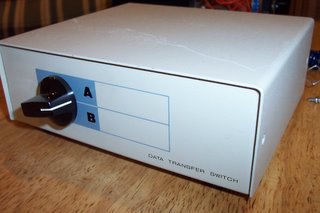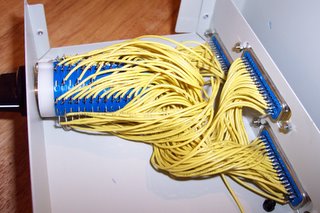 Procrastination has its price. As I finally decided to put up my projects online, I notice that there are others like myself, who like to save some money, and have their projects up and running. So, if I come across others that are the same as mine (or at least the same idea) I will post to their pages also.
Procrastination has its price. As I finally decided to put up my projects online, I notice that there are others like myself, who like to save some money, and have their projects up and running. So, if I come across others that are the same as mine (or at least the same idea) I will post to their pages also.
The DIY RCA Switch Box is not a new idea, (LifeHacker), just a little difficult to do. What you need to accomplish such a task is patients and time. You can always go and buy one, but if you need a certain configuration that might be expensive.
For mine, I needed 4 inputs to 1 output, and I didn't feel like spending more then $10. I found an old parallel printer A/B switch box, which was not being used (USB printers now), so I took it apart.
I found an old parallel printer A/B switch box, which was not being used (USB printers now), so I took it apart.
The first thing was that it was an A/B switch box and I needed an A/B/C/D switch box, well I got lucky. The key is in the switch itself. (more on that in a bit)
When you take it apart it might seem just a little overwhelming with all the wires, but in fact, it is really simple. You can either unsolder all the wires off or just cut them at the end NOT connected to switch.
You can either unsolder all the wires off or just cut them at the end NOT connected to switch.
I would recommend unsoldering off the switch end for easier testing of switch.
Now for the fun part:
Carefully take the switch apart. Now this part is hard to explain, the switches I had were A/B switches, but inside I flipped over the "how-many-positions" plastic piece and got what I wanted.
Now after we get the switch to the number of positions we need, its time for the task of figuring out how to set it up.
Because each application and switch are going to be different then mine, I will show how I did mine, and you can use that as a guide for yours.
All you have to do is get your trusty multi-tester with an ohm or continuity checker on it and start figuring your wiring diagram.
Here's a scan of mine.
 The color codes are for the switch positions. on the 4th position, I was only able to get mono because I broke one of the mini-contact points inside the switch.
The color codes are for the switch positions. on the 4th position, I was only able to get mono because I broke one of the mini-contact points inside the switch.
I don't know if you will be able to make heads or tails over my schematics, but maybe they'll help someone.
After you get the switch figured out, all you do is mount the connectors and solder the wires to them. I used the old A/B switch box as the new one, but I had to cover those huge holes where the parallel ports were. I used expansion card place holders. You know, those metal brackets you put in to cover the hole that's left from removing that unused modem out of your computer.
I used the old A/B switch box as the new one, but I had to cover those huge holes where the parallel ports were. I used expansion card place holders. You know, those metal brackets you put in to cover the hole that's left from removing that unused modem out of your computer.
That worked out well. Now my box is finished, except for the labeling on the front. I can connect my DVD, PS1, Camcorder, and for the mono jack, I got my computer plugged into that one. (s-video to composite cable).
I hope you can find this a help. Because you are in control of the wiring, you can make your own S-Video switch box, or DVI switch box, etc.
Just have fun
-=** UPDATE **=-
I have realized that my diagram is not easily interpreted, so I'll try to explain it.
First take a look at the picture of the actual switch. You will notice a lot of metal tabs sticking out. Those are the contact point to solder to. Now look at the diagram. You will notice that it is color coded. Those colors represent which contacts have continuity when in the corresponding switch position. There are three contacts per position. One for input and Two for output (A/B).
--For Example: Pins 4,5,6 have Blue and Green. ---Pin 4 connects with Pin 5 in switch position 1 --- Pin 6 connects with Pin 5 in switch position 2-- So you can have video-in on Pin 5 and video-out on pin 4 and 6.
The Yellow position didn't have any continuity to other pins, so I had to use another "disk". The switch I took apart was made up of several "disks". Yours might be different, so you'll just have to get out that trusty multi-meter to test the continuity of your disks.
If you have ANY questions, or I did not explain well enough, just send me and email at computerguru365 (at) gmail (dot) com. I will update as needed.
Tuesday, February 14, 2006
DIY RCA Switch Box **UPDATED**
Subscribe to:
Post Comments (Atom)

2 comments:
Hi,
Just wanted to let you know that I took inspiration from your switch box project and am in the process of building my own. Your diagram was intimidating at first, but it made perfect sense once I understood how the rotary switch was designed. Thank you very much.
I have a computer in a closet and a bar counter-top holding a computer monitor abutting the closet wall. To connect it all, I have a wall plate that has a VGA connector for the monitor and some usb connectors for the mouse and keyboard. It also has a L and R RCA jack that connects an XBox 360 (also sitting on the counter) with the TV (the TV is across the room and the wiring goes through the ceiling to the closet). The computer audio is sent to a receiver and then to 5.1 speakers.
Sometimes my son has a need for headphones when he plays computer games and others are watching TV or I am trying to get work done in the same room. The problem was that I forgot to put a headphone jack in the wall plate to connect to the computer, and even if I had, it is not convenient to swap the computer's audio-out cable from the receiver to the h/p every time. Rather than put a hole in the wall and add another wall plate just for a 3.5mm jack, I decided to make the RCA jacks on the wall for the XBox pull double duty and serve the headphones as well. So that's one switching need, and the other is to switch the PC audio between receiver and wall jacks. So that's two A/B switch boxes I'd need in my closet, and my closet is already crowded. And besides, I have an A/B switch box in there already, to switch between two monitors (the second monitor is in a computer cubby under the stairs). I looked at the switch inside it, but it only had a few disks, and they were all used.
So.... I got my hands on an old surplus 4-way switch that is the same make as the one you had, but a different model. It switches VGA (15 pins) and S-Video (6 pins) together so it has 21 inputs per way. The switch itself has 7 disks and each disk has 15 pins, in 3 groups of 5 (the 4 ways plus the common). 21 x 5 = 7 x 15, so every pin was used. My goal is to modify the wiring on this switch to accommodate both my existing VGA A/B switch and my new audio switching needs.
The switch positions will do the following audio switching:
Pos A - Wall jacks (for XBox) -> TV and PC -> AVR
Pos B - PC -> Wall jacks (for headphones)
Pos C - PC -> TV and Wall jacks (for XBox) -> AVR
Pos D - same as A
The switch positions will do the following monitor switching:
Pos A - cubby monitor
Pos B - bar monitor
Pos C - bar monitor
Pos D - bar monitor
Since 15 of the pins are used for video, I had 6 left for the audio, and needed 4 (wall L, wall R, PC L, PC R), with 2 to spare. I unsoldered the wires from the VGA terminals at positions C and D, and soldered the C wires to B and D wires to C at the switch pins, so that B, C, and D would all behave the same. I'm awaiting the RCA solder mounts in the mail to proceed with the audio piece. My biggest concern at this point is hole filling and positioning of the RCA plugs on the back of the box.
Thanks again for this.
Greaat post
Post a Comment